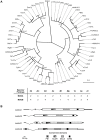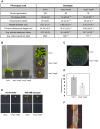A gene family derived from transposable elements during early angiosperm evolution has reproductive fitness benefits in Arabidopsis thaliana
- PMID: 22969437
- PMCID: PMC3435246
- DOI: 10.1371/journal.pgen.1002931
A gene family derived from transposable elements during early angiosperm evolution has reproductive fitness benefits in Arabidopsis thaliana
Abstract
The benefits of ever-growing numbers of sequenced eukaryotic genomes will not be fully realized until we learn to decipher vast stretches of noncoding DNA, largely composed of transposable elements. Transposable elements persist through self-replication, but some genes once encoded by transposable elements have, through a process called molecular domestication, evolved new functions that increase fitness. Although they have conferred numerous adaptations, the number of such domesticated transposable element genes remains unknown, so their evolutionary and functional impact cannot be fully assessed. Systematic searches that exploit genomic signatures of natural selection have been employed to identify potential domesticated genes, but their predictions have yet to be experimentally verified. To this end, we investigated a family of domesticated genes called MUSTANG (MUG), identified in a previous bioinformatic search of plant genomes. We show that MUG genes are functional. Mutants of Arabidopsis thaliana MUG genes yield phenotypes with severely reduced plant fitness through decreased plant size, delayed flowering, abnormal development of floral organs, and markedly reduced fertility. MUG genes are present in all flowering plants, but not in any non-flowering plant lineages, such as gymnosperms, suggesting that the molecular domestication of MUG may have been an integral part of early angiosperm evolution. This study shows that systematic searches can be successful at identifying functional genetic elements in noncoding regions and demonstrates how to combine systematic searches with reverse genetics in a fruitful way to decipher eukaryotic genomes.
Conflict of interest statement
The authors have declared that no competing interests exist.
Figures



Similar articles
-
Phylogenetic and Genomic Analyses Resolve the Origin of Important Plant Genes Derived from Transposable Elements.Mol Biol Evol. 2016 Aug;33(8):1937-56. doi: 10.1093/molbev/msw067. Epub 2016 Apr 28. Mol Biol Evol. 2016. PMID: 27189548 Free PMC article.
-
Transposable elements in Coffea (Gentianales: Rubiacea) transcripts and their role in the origin of protein diversity in flowering plants.Mol Genet Genomics. 2008 Apr;279(4):385-401. doi: 10.1007/s00438-008-0319-4. Epub 2008 Jan 30. Mol Genet Genomics. 2008. PMID: 18231813
-
Discovery of novel genes derived from transposable elements using integrative genomic analysis.Mol Biol Evol. 2015 Jun;32(6):1487-506. doi: 10.1093/molbev/msv042. Epub 2015 Feb 23. Mol Biol Evol. 2015. PMID: 25713212
-
[Evolution and development of the flower].Biol Aujourdhui. 2012;206(1):47-55. doi: 10.1051/jbio/2012007. Epub 2012 Apr 3. Biol Aujourdhui. 2012. PMID: 22463995 Review. French.
-
The major clades of MADS-box genes and their role in the development and evolution of flowering plants.Mol Phylogenet Evol. 2003 Dec;29(3):464-89. doi: 10.1016/s1055-7903(03)00207-0. Mol Phylogenet Evol. 2003. PMID: 14615187 Review.
Cited by
-
Thermo-Sensitive Spikelet Defects 1 acclimatizes rice spikelet initiation and development to high temperature.Plant Physiol. 2023 Mar 17;191(3):1684-1701. doi: 10.1093/plphys/kiac576. Plant Physiol. 2023. PMID: 36517254 Free PMC article.
-
Visual ModuleOrganizer: a graphical interface for the detection and comparative analysis of repeat DNA modules.Mob DNA. 2014 Mar 28;5:9. doi: 10.1186/1759-8753-5-9. eCollection 2014. Mob DNA. 2014. PMID: 24678954 Free PMC article.
-
Mutations mark cell lineages and sectors in flowers of a woody angiosperm.PLoS Genet. 2025 Aug 18;21(8):e1011829. doi: 10.1371/journal.pgen.1011829. eCollection 2025 Aug. PLoS Genet. 2025. PMID: 40825064 Free PMC article.
-
Co-localization of genomic regions associated with seed morphology and composition in a desi chickpea (Cicer arietinum L.) population varying in seed protein concentration.Theor Appl Genet. 2019 Apr;132(4):1263-1281. doi: 10.1007/s00122-019-03277-5. Epub 2019 Jan 19. Theor Appl Genet. 2019. PMID: 30661107
-
Phylogenetic and Genomic Analyses Resolve the Origin of Important Plant Genes Derived from Transposable Elements.Mol Biol Evol. 2016 Aug;33(8):1937-56. doi: 10.1093/molbev/msw067. Epub 2016 Apr 28. Mol Biol Evol. 2016. PMID: 27189548 Free PMC article.
References
-
- AGI (2000) Analysis of the genome sequence of the flowering plant Arabidopsis thaliana. Nature 408: 796–815. - PubMed
-
- Lander ES, Linton LM, Birren B, Nusbaum C, Zody MC, et al. (2001) Initial sequencing and analysis of the human genome. Nature 409: 860–921. - PubMed
-
- Doolittle WF, Sapienza C (1980) Selfish genes, the phenotype paradigm and genome evolution. Nature 284: 601–603. - PubMed
-
- Orgel LE, Crick FH (1980) Selfish DNA: the ultimate parasite. Nature 284: 604–607. - PubMed
-
- Wicker T, Sabot F, Hua-Van A, Bennetzen JL, Capy P, et al. (2007) A unified classification system for eukaryotic transposable elements. Nat Rev Genet 8: 973–982. - PubMed
Publication types
MeSH terms
Substances
LinkOut - more resources
Full Text Sources
Molecular Biology Databases

